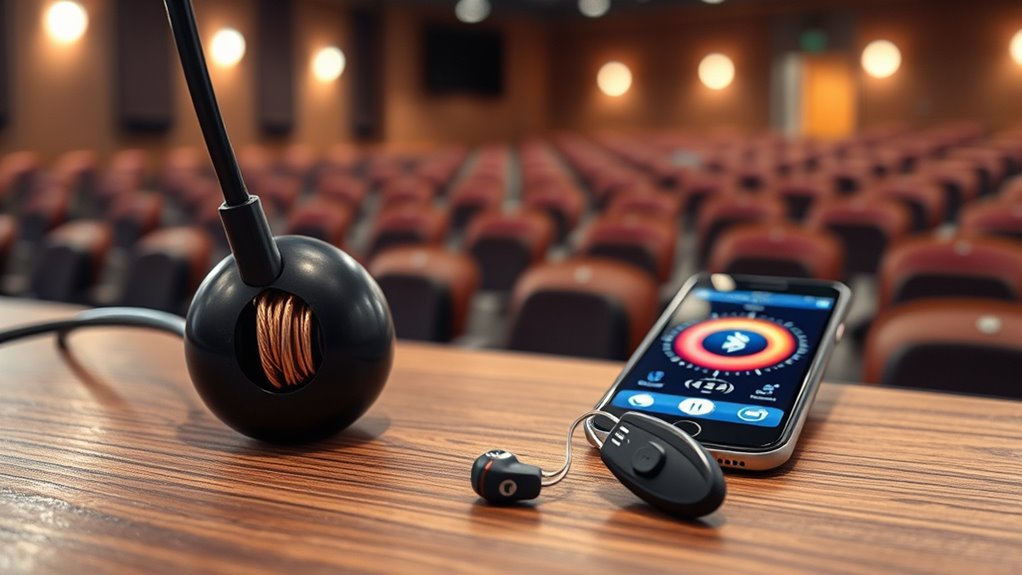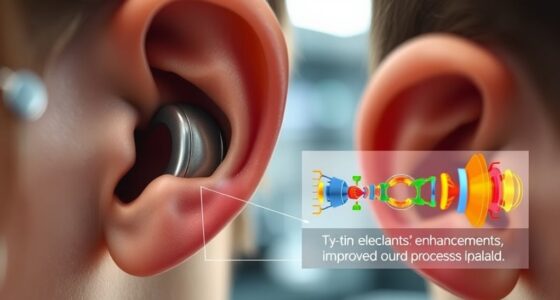Assistive listening technology has advanced from simple induction loop systems that convert sound into magnetic signals into modern wireless devices like Bluetooth broadcasts and FM systems. You can now enjoy clearer audio, reduced background noise, and seamless connectivity to smartphones and other gadgets. These innovations make communication easier and more natural, especially in noisy environments. If you’d like to explore how these technologies work and their future potential, there’s plenty more to discover.
Key Takeaways
- Assistive listening tech has evolved from simple amplifiers to advanced digital systems with wireless connectivity.
- Induction loop systems transmit magnetic signals to telecoils in hearing aids, improving clarity in noisy environments.
- Modern devices include Bluetooth broadcasts for seamless, secure streaming from smartphones and other audio sources.
- Digital and FM systems enhance sound quality and reduce background noise, supporting clearer communication.
- Future trends involve AI, neural interfaces, and augmented hearing to deliver personalized, natural listening experiences.
The Origins of Assistive Listening Devices
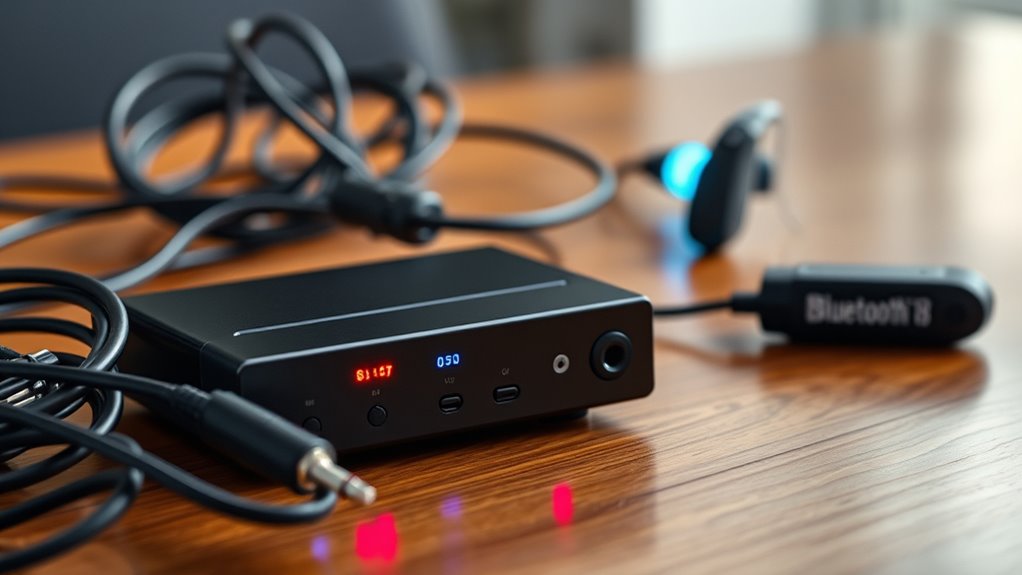
The development of assistive listening devices began as a response to the need for better communication for those with hearing impairments. Historically, these devices aimed to enhance auditory perception, allowing users to better detect sounds in noisy environments. Early innovations focused on amplifying sound directly to the ear, which marked a significant step in the historical development of hearing assistance. As technology advanced, devices grew more sophisticated, incorporating electronic components to improve sound clarity and reduce background noise. You can trace the evolution from simple hearing aids to more complex systems designed to address specific listening challenges. This progression reflects ongoing efforts to improve auditory perception, making communication more accessible and less frustrating for those with hearing difficulties. Additionally, modern assistive listening devices now include features like high-fidelity audio and wireless connectivity, further enhancing user experience.
How Induction Loop Systems Work

You might wonder how induction loop systems send sound directly to your hearing aid or cochlear implant. They use magnetic signals that are transmitted through a loop of wire installed around a room or area. The system’s components, including the microphone, amplifier, and loop wire, work together to deliver clear audio straight to your device. Additionally, advancements in assistive listening technology aim to improve sound quality and accessibility for users. These systems are designed to accommodate various hearing needs, ensuring that personalized solutions enhance the listening experience for everyone.
Magnetic Signal Transmission
Magnetic signal transmission is the core technology behind induction loop systems, enabling clear sound delivery directly to hearing aids and cochlear implants. When audio signals are processed, they generate a magnetic field that fluctuates in strength and direction, carrying the sound information. This magnetic field extends through the loop wire installed around a room or area, creating a consistent electromagnetic environment. Your hearing device’s telecoil picks up this magnetic signal, converting it back into sound with high signal fidelity. Because the transmission relies on magnetic fields rather than air conduction, you benefit from reduced background noise and clearer audio, especially in noisy environments. This direct transfer ensures you hear speech more distinctly, making induction loop systems an effective assistive listening solution. Additionally, the power output of electric bikes can influence the strength and clarity of transmitted signals, highlighting the importance of proper system design and installation. Proper maintenance of the loop system can also optimize signal quality and ensure consistent performance. Regular checks of the system components are essential to maintain optimal magnetic field strength and prevent signal degradation over time.
Loop System Components
Induction loop systems consist of several key components that work together to deliver clear sound directly to your hearing device. The main component is the loop wire, which creates a magnetic field around the area. An amplifier powers this wire, ensuring strong signal transmission. A microphone captures the sound source, sending it to the amplifier for processing. Modern systems often feature wireless integration options, allowing seamless connection to smartphones or other devices. User customization is also available, enabling you to adjust volume or tone settings for *ideal* clarity. When set up correctly, these components work harmoniously to transmit audio directly into your hearing device, reducing background noise. This setup provides a reliable, discreet listening experience, making it easier to follow conversations in various environments. Additionally, understanding the mind-body connection can enhance the overall experience of using assistive listening technologies by promoting relaxation and focus during conversations.
Advancements in Personal Amplification Devices
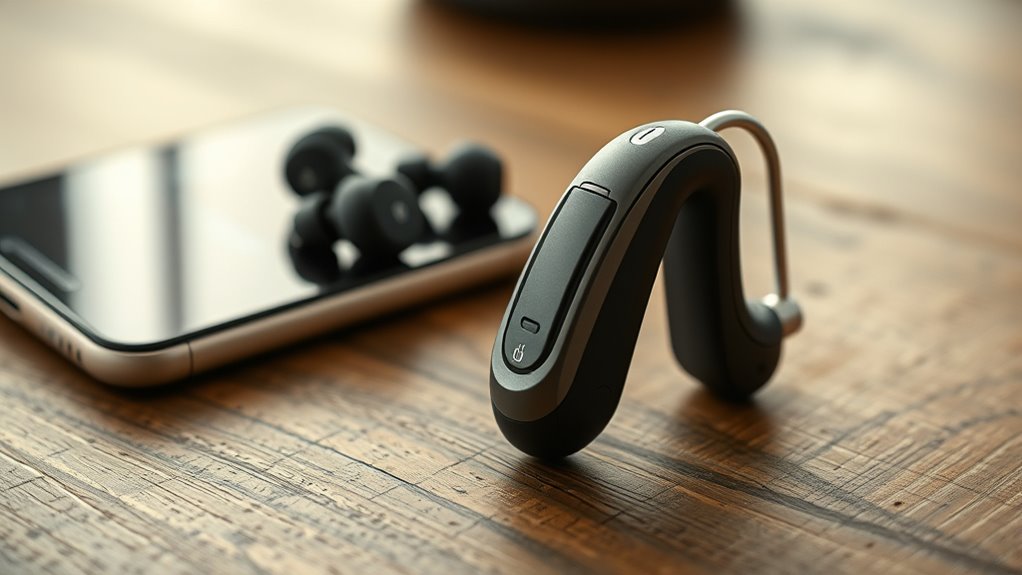
Recent advancements have made personal amplification devices more compact and portable, so you can easily carry them wherever you go. Improved noise reduction features help you focus on conversations even in busy environments. These innovations guarantee you get clearer sound quality with greater convenience. Additionally, global intelligence efforts have contributed to the development of more discreet and secure wireless transmission methods for these devices. Enhanced wireless communication technology ensures more reliable and secure connections. Furthermore, user-friendly design improvements allow for easier operation and customization tailored to individual needs. As security concerns grow, ongoing research into AI security vulnerabilities is vital to safeguard these communication methods from potential threats. Incorporating aesthetic wall organization solutions can also enhance the overall environment where assistive listening devices are used, creating a more comfortable and accessible space.
Compact & Portable Designs
Advancements in personal amplification devices have led to increasingly compact and portable designs that fit seamlessly into everyday life. Overcoming miniaturization challenges, manufacturers now pack powerful features into small, lightweight units, making them easy to carry and discreet to use. Ergonomic design considerations ensure these devices sit comfortably in your hand or pocket, reducing fatigue during extended use. The modern focus on user-centered design has also contributed to more intuitive controls and user-friendly interfaces, so you can operate them effortlessly. The emphasis on portability doesn’t compromise sound quality; instead, it enhances convenience without sacrificing performance. As a result, you can enjoy clearer hearing wherever you go, whether at work, social gatherings, or on the move. These innovations make personal amplification more accessible, adaptable, and unobtrusive in today’s busy world. These devices incorporate durable, lightweight components, such as materials that withstand daily wear and tear without adding bulk. Incorporating advanced miniaturization techniques, often inspired by automotive engineering, manufacturers have optimized internal components to maximize performance in a small form factor.
Enhanced Noise Reduction
How do personal amplification devices guarantee you hear more clearly in noisy environments? They utilize enhanced noise reduction technology to minimize background noise, allowing the desired sound to stand out. These devices analyze incoming sounds and filter out unwanted noise, improving signal clarity. Innovative materials and advanced algorithms detect speech patterns and suppress ambient sounds, making conversations easier to follow even in busy places. This means you can focus on speech without distraction, whether in a crowded restaurant or a noisy room. The improved clarity ensures you catch more details and engage confidently in conversations. Additionally, many devices incorporate headphone compatibility features that optimize audio delivery for various headphone types, further enhancing listening quality. As a result, these devices offer a more natural listening experience, helping you stay connected and aware, regardless of the noise level around you. Moreover, the integration of AI-driven noise suppression offers real-time adaptability to changing environments, further refining auditory clarity.
The Rise of Digital and FM Systems

Digital and FM systems have transformed assistive listening by providing clearer sound and reducing background noise, making it easier for you to focus in challenging environments. These systems utilize digital integration, allowing seamless connection to various devices, and offer user customization to suit your specific needs. You’ll notice improved speech clarity, especially in noisy settings like theaters or classrooms. The ability to personalize settings ensures a comfortable and effective listening experience. Additionally, advancements in AI Security contribute to safeguarding these devices against cyber threats, ensuring your listening environment remains secure. Incorporating sound healing science principles, these systems can also promote a more holistic approach to auditory health.
Wireless Connectivity and the Shift to Bluetooth

Have you noticed how Bluetooth technology has revolutionized assistive listening devices? It uses advanced wireless protocols to provide seamless, reliable connections between your device and various audio sources. Bluetooth’s simplicity means you can connect quickly without cumbersome setups, enhancing your listening experience. Improvements in battery technology also play an essential role, making these devices more portable and long-lasting. Modern batteries last longer, so you don’t have to worry about frequent recharging during the day. This shift to Bluetooth offers greater flexibility, enabling devices to stream audio directly from smartphones, tablets, or computers. As a result, your assistive listening experience becomes more integrated, convenient, and user-friendly, all thanks to innovations in wireless protocols and smarter battery tech. Additionally, understanding the various appliances connection options can help users optimize their devices for better compatibility and performance. Exploring wireless compatibility can further enhance device usability across different platforms and environments, especially with the integration of multi-functionality features in newer models. For example, some devices now incorporate customizable settings that allow users to tailor sound profiles to their specific hearing needs. Embracing battery efficiency can also contribute to longer device usage and reduce environmental impact.
Current Trends and Future Innovations
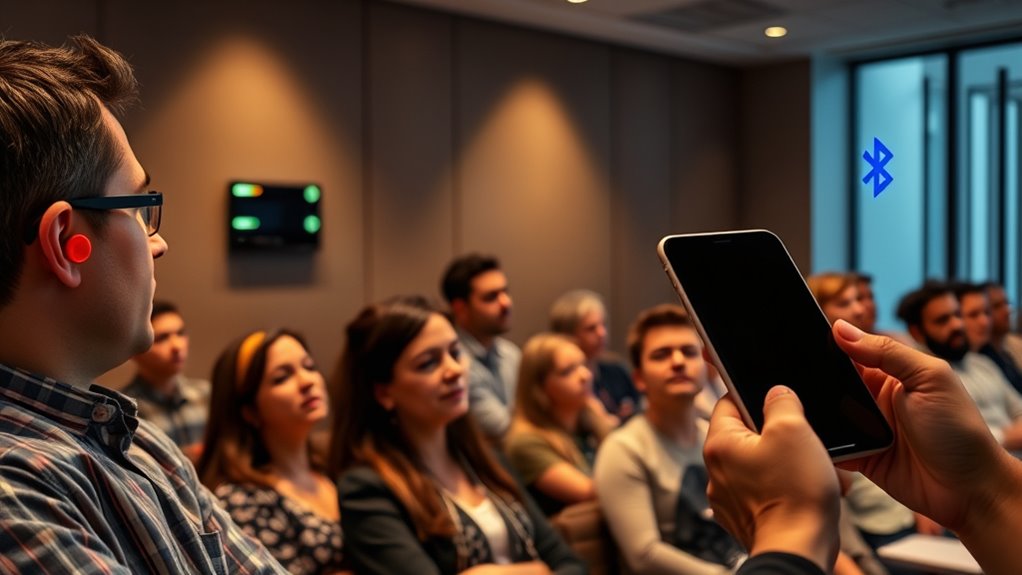
Recent trends in assistive listening technology focus on integrating artificial intelligence and machine learning to enhance user experience. These innovations aim to create seamless, personalized sound environments. Neural interfaces are emerging to directly connect devices to your nervous system, offering more natural augmented hearing. Future developments include:
Emerging assistive hearing tech leverages AI and neural interfaces for seamless, personalized, and natural sound experiences.
- Advanced neural interfaces that enable real-time sound processing directly in your brain.
- AI-powered devices that adapt automatically to changing environments.
- Augmented hearing systems that filter background noise and emphasize speech.
- Wireless brain-computer interfaces that improve sound clarity without manual adjustments.
These trends aim to make assistive listening more intuitive, natural, and effortless, paving the way for smarter, more integrated hearing solutions that anticipate your needs.
Impact on Accessibility and Communication
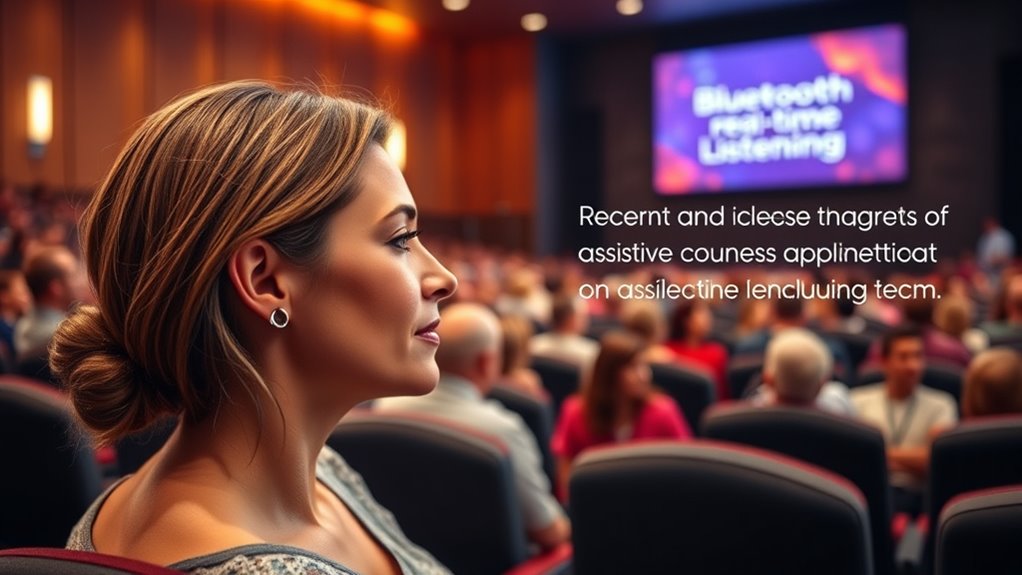
How do advancements in assistive listening technology transform accessibility and communication for individuals with hearing impairments? They notably improve auditory accessibility by reducing background noise and focusing on speech, making conversations clearer. These innovations enable you to participate more fully in social, educational, and professional settings. With tools like Bluetooth broadcasts and induction loops, you experience seamless communication enhancement, breaking down barriers caused by hearing loss. Enhanced auditory accessibility means you no longer have to rely solely on lip-reading or sign language; you gain a more direct connection to spoken words. These technologies foster independence and confidence, ensuring you stay engaged and informed. Overall, they create a more inclusive environment where effective communication is accessible to everyone, regardless of hearing ability.
Frequently Asked Questions
How Do Assistive Listening Devices Integrate With Mainstream Technology?
You might wonder how assistive listening devices integrate with mainstream technology. While integration challenges exist due to compatibility issues, manufacturers are improving device interoperability. You can customize your experience with features like Bluetooth connectivity, allowing seamless streaming from smartphones and other devices. This enhances accessibility, but staying aware of compatibility and software updates helps guarantee your devices work smoothly together, giving you a tailored listening experience.
Are Assistive Listening Devices Cost-Effective for Widespread Adoption?
When considering if assistive listening devices are cost-effective for widespread adoption, you should conduct a thorough cost-benefit analysis. This helps determine if the benefits, like improved communication and accessibility, outweigh costs. Funding strategies, such as government grants or subsidies, can support adoption. Ultimately, investing in these devices can enhance quality of life for users and promote inclusivity, making them a worthwhile expense when backed by solid financial planning.
What Are the Privacy Considerations With Bluetooth Broadcasting?
Imagine a world where technology whispers secrets—bluetooth broadcasting raises privacy concerns. You must consider data privacy, as these signals can be intercepted, risking sensitive info. User consent becomes crucial; you should guarantee users understand how their data is shared and stored. Without transparency, trust erodes. So, when using Bluetooth broadcasts, prioritize privacy measures, obtain clear consent, and safeguard personal info to maintain confidence and uphold ethical standards.
How Do Assistive Devices Accommodate Various Hearing Impairments?
You’ll find that assistive devices accommodate various hearing impairments by addressing auditory processing differences and sensorineural diversity. These devices amplify sound, filter background noise, and enhance speech clarity, helping you better interpret sounds. Customized settings and advanced technology guarantee you get a tailored experience, making communication easier regardless of your auditory processing challenges or the specific nature of your sensorineural hearing loss.
What Training Is Required for Effective Use of Advanced Systems?
You need proper user training and education to effectively operate advanced assistive listening systems. This means learning how to set up, connect, and troubleshoot devices like Bluetooth broadcasts or induction loops. You should also understand system features, such as volume control and pairing procedures. Regular user education guarantees you’re confident in using the technology, maximizing its benefits and improving your overall listening experience.
Conclusion
While some might think new assistive listening tech is complicated or costly, it actually makes communication easier and more accessible for everyone. Whether it’s induction loops or Bluetooth broadcasts, these innovations break down barriers and connect you more effortlessly. Embracing these advancements means you won’t miss out on important moments or conversations. So, don’t let worries about technology hold you back—these tools are designed to enhance your life and keep you truly connected.

